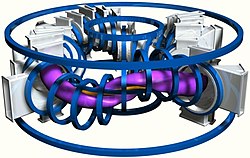| Tokamak de la Junta II | |
|---|---|
 CAD drawing of TJ-II | |
| Device type | Stellarator |
| Location | Madrid, Spain |
| Affiliation | National Fusion Laboratory of Spain |
| Technical specifications | |
| Major radius | 1.5 m (4 ft 11 in) |
| Minor radius | 0.2 m (7.9 in) |
| Plasma volume | 1 m3 |
| Magnetic field | 1 T (10,000 G) |
| Heating power | 2 MW |
| Discharge duration | 0.2 s |
| History | |
| Date(s) of construction | 1991 – 1996 |
| Year(s) of operation | 1997–present |
| Preceded by | TJ-I |
| Related devices | TJ-K |
| Links | |
| Website | https://www.fusion.ciemat.es/inicio/tj-ii/ |
TJ-II is a flexible Heliac installed at Spain's National Fusion Laboratory. [1]
Contents
- History
- Precedents
- Description
- Parameters
- Goals and Research
- Experiment
- Theory
- References
- Further reading
- External links
Its first plasma run was in 1998, [2] and as of 2024 is still operational.